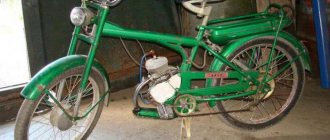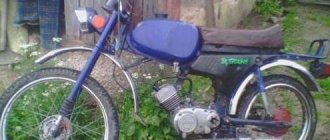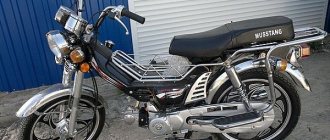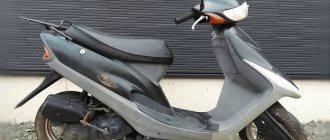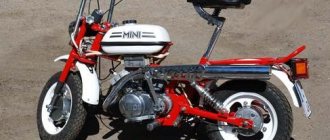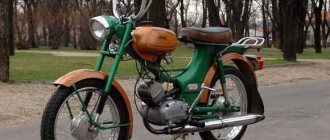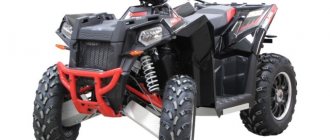Serial production of Riga mopeds began 59 years ago. It was 1958 then. The first moped was the Riga-1 model. The production of this motorcycle equipment completely ended in 1998. As for the Riga 7 moped, its mass production began in 1969. All models were equipped with single-cylinder gasoline engines of varying power. These were reliable single and two speed vehicles. By the way, the working volume of these engines reached 50 cm³. The maximum speed of the latest models of the Riga 13 moped was 60 km/h.
Features of the moped
The release of Riga 7 mopeds was carried out together with the Riga-5 model, which at that time had not yet been withdrawn from mass production. However, it was completely discontinued in 1971. A certain notability of the Riga 7 moped was the D-6 engine, which had enough power for long trips, for the headlight, and also for the brake light. Unlike previous models, this one came with interchangeable wheels, a chrome muffler and a toolbox.
Product Specifications:
- Length – 186 cm.
- Width – 65 cm.
- Height – 105 cm.
- Tubular frame.
- Engine power is 1.2 horsepower.
- Spring shock absorbers.
- Telescopic front fork.
- Gasoline consumption per 100 km is no more than two liters.
- The maximum speed is 40 km/h.
Riga mopeds model 1976-1977
Since October last year, the Riga motorcycle has replaced the light moped " Riga
- 7" began to produce a new model - "Riga - 11", and from the beginning of the current one - instead of the moped "Riga - 12" - "Riga - 16".
Many years of experience in operating previous models, especially in rural areas, revealed the need to improve a number of components and parts. Their modernization has made it possible to significantly improve such important qualities of the machines as reliability, traffic safety and ease of use. At the same time, we managed to give them a more attractive appearance. Let's look at the main design innovations.
Technical and operational characteristics of the moped Riga 11
The single-speed model Riga 11 replaced the Riga-7. It was given a more stylish appearance and equipped with powerful wheels. The engine remained the same - “D-6”. However, the model turned out to be quite heavy, and the frame was not entirely strong. In addition, the original fuel tank caused some inconvenience when driving uphill. If there was little gasoline left in it, then it did not enter the combustion chamber.
Specifications:
- Length – 197 cm.
- Width – 75 cm.
- Height – 150 cm.
- Spring shock absorbers.
- Telescopic front fork.
- The maximum speed is 40 km/h.
Riga—11
The spinal-type frame is a strong central tube to which fastening elements for the front fork, engine, rear suspension pipes and other parts are welded. It is distinguished from the previous frame by greater rigidity and durability. Due to the change in the frame, the dimensions of the front fork have changed, although the technical parameters remain the same.
O is the first production model in our country with a backbone frame.
The weakest component in the Riga-7 design were the wheels, the rims of which often failed when driving on roads with uneven surfaces, with stones and potholes. The use of larger section tires on the Riga-11 (2.25-19 instead of 2.00-19 inches) and a reinforced rim will practically ensure long-term operation of the vehicle even in difficult road conditions. The design of the wheel elements remains unchanged.
For a more comfortable driving position, the steering wheel is made high. The fastening method - using two earrings with nuts - allows you to easily and securely fix it in the most suitable position. The clutch and front brake release levers are equipped with rubber ball-shaped tips to prevent injury in the event of a fall.
The design of the saddle has been changed - its box and the thickness of the cushion have been increased. This is done to improve the driver's position and add space for tools. New elements are used in the seat spring fastening, ensuring high manufacturability and reliability of the entire assembly.
The fuel tank located at the rear of the moped together with the trunk forms a fairly large platform on which up to 15 kg of cargo can be transported. The trunk rack prevents the load from sliding and at the same time serves as a handle for moving the moped. The fuel tank volume (4 l) provides a power reserve of up to 200 kilometers. This allows you to make quite long journeys, but on roads remote from gas stations, trips “out into nature”. City dwellers - lovers of such trips and rural residents, will certainly be glad to see a stronger and more durable chain in the motor transmission on the new car.
The engine on Riga-11 is the same as before - D-6. But due to the wide tires, it is shifted to the left from the plane of symmetry of the frame by 7 mm, so that the front and rear final drive sprockets are located in the same plane.
The stand has been made more durable and at the same time more technologically advanced.
Moped Riga 12
The two-speed model is equipped with a Sh-57 engine, which contains bicycle-type pedals. They help the owner of a Riga 12 moped drive up a steep mountain. The model was equipped with fuel tanks of different shapes. This moped differed from the Riga-16 in having a shorter seat and a smaller trunk.
Technical characteristics of the Riga 12 model:
- Length – 197 cm.
- Width – 74 cm.
- Height – 116 cm.
- The power of the single-cylinder engine is 2.2 horsepower. Working volume – 49.8 cm³.
- More modern, improved steering wheel.
- The maximum speed is 50 km/h.
- Weight – 75 kg.
Riga—16
Comparing both new mopeds in appearance, you can immediately notice that they have almost identical handlebars of a modern shape, including the method of fastening. Together with the new elongated saddle, which has deep embossed embossing, this handlebar provides a comfortable fit that does not tire the driver even on long trips.
In the front fork shock absorber, the gap between the movable and fixed tubes of the stay is covered with a rubber corrugated cover, which reliably protects the cavity of the stay from water and dust. This extends the service life of parts.
To accommodate larger loads, the trunk area has been increased by 300 cm2. Its tubes now have a multi-layer decorative coating.
equipped with a rear light that is clearly visible in the dark and has a modern design with a large reflector.
The Riga-16 has the same engine as the Riga-12. This is the famous Sh-57 motor. In the future, it is planned to replace it with a Sh-58 engine with starting not from the pedals, but via a kick starter.
Painted with bright enamels and two-color stickers, the new mopeds look more attractive than the previous ones.
deputy chief designer
TECHNICAL CHARACTERISTICS “RIGA-11” and “RIGA-16” (in parentheses) . length—1970 (1850) mm; width -750 (750) mm; height - 1150 (1060) mm; weight (dry) - 44 (54) kg; maximum speed - 40 (50) km/h; average fuel consumption -2.0 (2.2) l/100 km; engine: model D - 6 (W -57), displacement - 45 (49.8) cm3, cylinder diameter and piston stroke - 38 and 40 (38 and 44) mm, compression ratio - 6.0 (8.2 - 8.5), power - 1.2 (2.2) l. With. rpm - 4500 (4900 - 5000); fuel-gasoline A-76 or A-72 mixed with oil; wheels - non-interchangeable (interchangeable); tire size: 60 - 484 (65 - 405) mm, or 2.25 - 19 (2.50 - 16) inches.
Technical characteristics and features of the moped Riga 13
After the appearance of the lightweight Riga 13 model, its main drawback immediately became apparent: the ignition was constantly interrupted. This was the biggest problem because the engine never started right away, so I had to ride the moped downhill for a long time with the gear in gear. In addition, the engine often turned off when idling. Manufacturers have partially eliminated this problem.
Technical characteristics of moped Riga 13:
- The power of a single-cylinder two-stroke engine is 1.3 horsepower. Working volume – 45.4 cm³.
- Cooling is air.
- The maximum speed is 40 km/h.
- Gasoline consumption per 100 km is 2 liters.
- Magneto ignition.
- The clutch is double-disc.
- The front fork is telescopic.
- Shock absorbers are spring.
Many Soviet teenagers dreamed of owning the Riga 13 model. It was this moped that became the most successful and reliable development of Riga engineers. Since the lubrication of the rubbing parts of the engines of mopeds of all Riga models was not systematic, motor oil was added to gasoline in a certain proportion, and this mixture lubricated the rubbing parts. Without lubrication, the engine fails instantly.
A distinctive feature of this model was the high-quality bright light of the headlights. The problems associated with the ignition coil were eliminated using a new high voltage transformer. As for engine malfunctions, the cause was the material from which the breaker hammers were made. They wore out quickly and did not reach the magneto cam. This was the reason for the failure to start the engine.
Riga mini wiring diagram
Welcome to the Riga Mini Stella Fans community page, here you will find information you are interested in on the operation and repair of Soviet mopeds, in particular. Below, the article offers various options for scooter schemes, perhaps some will suit you. On one minivan, the blue one, it was cut and a circuit with turn signals was installed in it. Mini rig wiring diagram. Because the tidy is not yet available, and the mini already wants to be disassembled for cleaning. Photos of the Riga30 minimoped are attached... Back in 1982 at Rizhsky. Please give me a diagram of anyone who has a wiring connection in the Carpathians. 5mm, no cambrics needed, everything fits perfectly. I wanted something quick and easy to lift https://wap.google.com/xhtml/search?q=Porno+ya%C5%9Fl%C4%B1+iri+site:wiga.xyz&num=100&filter=0&gbv=1&sei= 0 spirit, and I decided that it would be a mini Riga. Electrical diagram of mopeds Riga4, Riga12, MP046, Verkhovyna from 3 to 6 models.
Quote from August 16, 2014, 16 35 53 You just need to check the wing at full suspension travel. There is no point in increasing the dimensions of the Mini by lengthening the frame. Electrical equipment The schematic diagram of electrical equipment is shown in. BKS stabilizer switch circuit - MOPEDIST. However, with a weight of 50 kg, it was very problematic to drag one. I sell wiring for Riga mini, I do it myself, good wires, tinned terminals, crimped and soldered, heat-shrink. Stages of conversion of Riga Mini 26 with an engine from Alpha.
I was stunned by the Chinese wiring, judging by common sense, the black wire is ground and the green one is some kind of plus, but no, the black one is a plus after turning on the ignition and the green one is a minus for everything that is in the moped. I have a Riga 16 with a Sh58 engine, I don’t know exactly what kind of car it is, but it looks like a motorcycle. And on Riga mini Lux three switches were installed. Look at the wiring diagram from any moped with a B50 engine. Hello, tell me what to do. Rigamini is still lying in a pile of parts; it requires an incentive to start assembling. But after the collapse of the UNION, the car plant died a natural death because it was no longer needed by the bourgeoisie.
Electrical equipment of the circuit - MOPEDIST.
Mini, on the contrary, where on the BKS it is written Z and D this is to the generator, on the other side where K is to the coil, O2 light, O1 signal. Just yesterday I finished the electrics inside the engine itself and I want to share some information. As the engine was overhauled, I didn’t even try to start it. In addition, for other wiring diagrams Riga 16, Carpathians and some old motorcycles, there is a lower left contact in the switch that is closed with a pin on which the switch goes. I'm interested in the wiring diagram, the length of the harnesses, where you bought the chips for the taillight and the chips for the BKS. Detailed explanation with photos, electrical diagram of fuse and relay blocks for Moto cars. Electrical wiring diagrams for scooters differ depending on their model. The beginning of restoration, or rather refreshing, of the mini Riga Forum. Minimoped Riga26 Moped from Soviet childhood RigaMini minimokic, which has compact dimensions and weight, reaches speeds of up to 50.
Electrical diagram of mopeds Verkhovina7, Karpaty, Karpaty2, Mini, Delta, Stella. Riga13 BSZvet how to UNSEE illuminated by LED. I want to replace the factory carb with some other, more reliable one. Someone post a photo where you can see everything or give a link where you can see it. I could not find patterns with other colors, as well as the original pattern from this particular model, on the Internet. Hello, I came to the conclusion that it’s time to do a project, my hands were itching, I didn’t go to the garage for 4 months. Just stubs, no switches, no frog that turns on the brake light, no pieces of wiring at all.
Please tell me the length of the cable and its free play of the foot brake for the Riga mini, since on my copies they are too big, it’s clear that they were chosen somehow by chance and the appearance is not right. Messages 37 Registration date https://wap.google.com/xhtml/search?q=%D0%A4%D0%BE%D1%82%D0%BE+%D0%B2+%D0%B0%D0%BD%D0 %B0%D0%BB+%D0%BC%D0%B0%D0%BB%D0%BE%D0%BB%D1%96%D1%82%D0%BA%D1%83+site:qune.xyz&num=100&filter =0&gbv=1&sei=0 20121214 Age 22 From Moscow. First, you should assemble the circuit and, WITHOUT CONNECTING THE LIGHTING, make sure it is working and start the engine. For stable, uninterrupted operation of the motor, you need to carefully set the gap on the breaker. I have attached an intelligible diagram for connecting to the remote control. Electrical circuit diagram of the Master Vintik scooter. When starting the moped, the headlight does not light up and the sound signal does not work.
Color diagram of electrical equipment of mopeds Riga4, Riga12.
It is better to assemble the wiring as in Riga22, otherwise there are no difficulties, everything fits. There are two wires going to the woman from the switch. Light on moped Riga 13 Motorcycles, scooters Metal. Let's forgive the boy for the confusion, he will go through the wiring, find a break, and then maybe he will correct us in some way, over time. Help me on how to correctly install the wiring from the engine to the hull, preferably with a photo. Rigamini moped, review, characteristics, tuning. For some reason, in our area, such a moped is a curiosity and actually buying even a soup set was not easy. But the motors and wiring diagram are the same as in Riga. Yesterday I wove new wiring for the Mini Riga, but I still didn’t seal it in PVC and heat shrink. Mini rig wiring diagram. everything is covered in cambric, white or black as desired. We need electrical circuits for rig 16 for the high-beam front light, parking brake rear light and front parking light, a car LED will do.
Features of the Riga 16 moped model
The production of mopeds in this series did not end with the Riga 16 model. There were also mopeds: “Riga-17S”, “Riga-22”, “Riga-26”, “Riga SZ-80”, as well as “Delta”, which is also from this model range. The Riga 16 moped went into mass production 40 years ago. This two-speed model was equipped with a motorcycle-style muffler, kickstarter, rear brake light, as well as improved steering and new body kits.
Technical characteristics of the moped:
- Length – 197 centimeters.
- Width – 74 centimeters.
- Height – 116 centimeters.
- With an engine displacement of 49.8 cm³, its power was two horsepower.
- The clutch is double-disc.
- Two-speed manual transmission.
- Gasoline consumption per 100 km is only 1.6 liters.
The engine of the Riga 16 moped was started by a kickstarter or like its first predecessors. The man sat behind the wheel and turned the pedals, thanks to which the magneto came into operation and the engine started. In addition, it was possible to lift the moped by the seat, and the rear wheel would lose its grip on the asphalt. In this position, you had to turn the pedals with your free hand, thanks to which the engine started. After this, the gear was set to neutral, the rear wheel was placed on the road, and the engine could idle.
This model was equipped with a strong, reliable frame, wider stable wheels and an improved seat. The Riga-16 moped was characterized by an optimal combination of carrying capacity and dead weight. Production of this model ended several decades ago. Despite this, many Russians and Riga residents remember all the mopeds in this series. And today the Riga 13 moped is used by a small number of people. This is an indicator of the reliability of the Riga moped series.
Consumer Reviews
Despite the fact that more than a dozen years have passed since the release of the modification in question, you can still find the rare device in working condition. Of course, finding original parts for it is almost impossible. But, thanks to the ease of maintenance and repair, it is quite possible to repair the motor yourself with minimal skills.
The owners of the device note a number of positive aspects of the Riga moped:
- new and more comfortable steering wheel design;
- improved seating;
- optimal combination of unit weight and its load capacity;
- stable wheels compared to predecessors;
- starting the engine using a kick starter;
- strong and reliable frame.
The disadvantages for users of this model include problems with engine components typical of Soviet vehicles of this class, a capricious gearbox and a not-so-perfect brake system.
Story
"Riga-1"
In 1958, the first moped was produced in Riga. The experience was not entirely successful, and the plant designers went to the Czech Jawa plant for a detailed acquaintance with the production of small-capacity motorcycles. After this, in 1960, 11 copies of “Riga-1” were produced and sent for testing. In 50 days, the copies traveled 10,000 km and the following year 5,000 pieces were produced, in 1962 - 27,000, and in 1965 - more than 90 thousand copies.
"Riga-3"
In 1965, the Riga-1 model was discontinued and was replaced by a new model, Riga-3, equipped with a Siauliai-made Sh-51 engine. However, these engines turned out to be not as reliable as Czech ones and the popularity of mopeds waned. Externally, the Riga-3 moped was not very different from its predecessor, except for the modified shape of the tank, a cushion-type seat and a frame with an extended tail section. "Riga-3" turned out to be almost 30% more powerful than "Riga-1", lighter by 2 kg and accelerated to 50 km/h.
"Riga-4"
From 1970 to 1974, Riga-4 was produced. This model was very similar to the Riga-3 and differed only in a small change in the hull lining and the introduction of new technical solutions to the design: the electrical circuit was changed (a high-voltage transformer was added), the design of the guards for the wheels and chain, the design of the gearbox gears, the trunk, installed new wheels of smaller diameter, and the speedometer was driven by the engine.
"Riga-5"
“Riga-5” began to be produced in 1966 and was very different from the predecessors of the “Riga” series and from the “Gauja”, in which not a telescopic fork was used to dampen the front wheel, but compressed springs, allowing the fork to bend forward. The design has also been completely changed. The D-5 series engine without gears, started by pedals, made a moped
easier to control, but the dynamics of the moped have worsened.
"Riga-5" initially had a classic bicycle hub on the rear wheel, providing braking in the same way as a bicycle. But already in 1968, a modification appeared with shoe-type brakes on the rear wheel, and for some time both modifications were produced in parallel, after which shoe brakes completely replaced the bicycle-type rear hub. The frame was also strengthened (the corner bracket was lengthened), because the frames of previous models often cracked when driving on bad roads in the area adjacent to the steering column.
With proper engine adjustment, Riga-5 ensured starting from a standstill without the help of pedals and, in exactly the same way, “took” very steep uphill climbs. For example, starting the engine
just before an ascent of approximately 45°, it was possible, by smoothly releasing the clutch, to drive up a slope of any length without pedal assistance, provided that the quality of the road surface was not too bad.
In addition, for the D-5 and D-6 engines, it was important to very carefully adjust the supply of the fuel mixture so that when idling at maximum speed, the engine would neither stall nor “choke” with fuel. The model was produced until 1971 inclusive, after which it was replaced by the Riga-7 moped.
"Riga-7"
-7" began to be produced in 1969. By the end of 1971, it completely replaced the Riga-5 moped. Unlike the Riga-5, it was equipped with a D-6 engine, which made it possible to connect a headlight and rear marker to it; they broke on bad roads at the place where the steering column was attached; The decorative hood of the drive chains has been removed. The design of the Riga-7 moped had a special rack installed to prevent frame breakage in cases of emergency braking. Plant workers H. Akermanis (electrician) and J. Bankovich (mechanic) proposed and tested, both on the stand and in practical driving conditions, a frame design with reinforced rear suspension without a rack. The proposal was accepted, royalties were paid within the terms stipulated by law, but in 1976 the Riga-7 moped was discontinued, replacing it with the Riga
-11».
"Riga-11"
"Riga-11" came out as a hybrid of "Riga-7" and, in fact, the basic model "Riga-9". It was supposed to produce a moped
, equipped with an engine with an automatic clutch, but after testing the manufacturer refused to install this engine, changing the design of the moped frame for the D-6 engine. Wheels of a smaller diameter, but with thicker tires, the original look attracted buyers, but in practice the original look was not in favor of this model. The tank located under the trunk made driving uphill difficult, especially when there was little gas. But the original frame turned out to be fragile.
"Riga-13"
"Riga-13" replaced "Riga-11". Moped
produced since 1983 [1]. It was equipped with a 1.2 hp engine with a maximum speed of 40 km/h. Early models were equipped with the D-8 engine [2]. the most common engines are D-8e, D-8 m. Its distinguishing feature is good light and an installed high-voltage transformer, which eliminated frequent problems with the ignition coil. However, the model often failed to ignite: after all, the material of the breaker hammer touching the magnet cam was abraded, which was a typical phenomenon for engines of the “D” series. In “D-6”, in addition, they “modernized” the fastening of the magnetic rotor of the magneto, reducing the knurling depth, as a result of which the magnets often broke off from the central bushing, and the ignition stopped working).
This model was produced until 1998. “Riga-13” is the most popular model of the “Riga” mopeds. One of the disadvantages is the frequent breakdown of the clutch cover.
"Riga-16"
In 1977, the two-speed Riga-16 model was put into production (there were also experimental models in 1976 [3]). It was already a mokick with a kickstarter, a motorcycle-type muffler, a new steering wheel and a tail light. The first Riga-16 models still had the Sh-57 engine; later, one of the most successful Šiauliai engines was installed on the Mokika. This is the first mokika model in the USSR. before that there were only mopeds (that is, with pedals), the closest competitors “Verkhovyna-7” and “Karpaty” came out only in 1981.
"Riga-17S"
Since 1983, the Riga-17S model was launched into production at Riga. Since the Riga Motor Plant does not have its own engine production and corresponding experimental base, VNIImotoprom took over the design and production of the engine for the racing moped, and Sarkana Zvaigen developed the crew part and fine-tuned the machine as a whole. Engine with a volume of 49.8 cubic centimeters and a power of 16.5 hp. allowed the moped to accelerate to 153 km/h.
"Riga-22"
In 1981, the Riga-22 mokik rolled off the assembly line, which became an improved version of the Riga-16 mokik. This model, which accelerated to 50 km/h, was equipped with the Sh-62 engine. This engine was radically different from previous models, primarily in its powerful electronic ignition and gearbox, which is why it was necessary to change the direction of rotation of the crankshaft. The use of electronic non-contact ignition increased the reliability of engine starting and the reliability of the ignition system as a whole. However, the first models were distinguished by the unreliability of the commutators and gear unit. Therefore, after some time, the engine and switch were modernized, and since 1984 they began to produce mokikis with Sh-62M engines with a power of 1.8 liters. With. In addition, the design of the muffler has changed. Despite the modernization, the gearbox still caused trouble for customers. The cross-country model, unified with the Riga-22 moped, became the Riga-20Yu moped, which was equipped with a more sporty frame, a larger diameter front wheel and foot-operated gear shifting. It was a small-scale moped intended for training and competitions of young athletes.
"Riga-26" / "Riga-30" / "Riga-Mini" / "Stella"
In 1982, the mini-mock “Riga-26” (aka “Mini” RMZ-2.126) was developed. This model combined the advantages of a moped and a scooter, was simple and easy to store, and, moreover, did not lose its resemblance to a traditional motorcycle. "Riga-26" took up little space: it could easily fit on the roof or in the trunk of a car, in an elevator, on a balcony or in a utility room of a residential building. However, with a weight of 50 kg, it was very problematic to drag such a mini-mock up the stairs to the balcony or loggia. The wheels of this model were of small diameter (like those of a motor scooter) and were often deformed when hitting holes in the asphalt. The handlebar handles, if the clamping collets are released, can be rotated down, almost halving the height of the machine. For the same purpose, a device was provided for lowering the saddle.
However, the handling and maneuverability of the mini-mokika " Riga
-26” certain claims were made. For example, the tires were so hard that an accidental puncture was simply unnoticeable, and the owner noticed the damage only when inflating the tires, and the engine
The V-50 with an electronic ignition system was difficult to adjust the ignition system. A little later, Czechoslovakian-made engines with a horizontal cylinder position began to be installed on this mokick, which were much more reliable and operated almost silently, and also had a foot-operated gear switch. "Riga-30" (RMZ 2.130) was distinguished by a spring rear suspension versus the rigid one of 2.126.
"Delta"
In 1986, the Delta mokick (RMZ 2.124) was released - this is a continuation of the Riga moped series with a new frame and engine. Mokik had modifications “Sport”, “Tourist”, “Lux”. There were also Deltas with cast wheels and an engine with a three-speed gearbox made in Poland.
Spark plug conditions
a) Normal appearance
Type of spark plug: light gray to brown with slight sediment, as well as slight electrode erosion. Conclusion: the engine condition is normal, the air-fuel mixture and ignition are adjusted correctly; the glow number of the candle is selected correctly; there are no ignition interruptions; The engine cold start system is working.
b) Soot contamination
Type of spark plug: dry soft soot of intense black color on the insulator, electrodes and spark plug body. Consequences: poor engine starting; poor operation of a cold engine; interruptions in ignition of the air-fuel mixture; bad reaction to gas. Probable causes: incorrect throttle position; excessively rich air-fuel mixture; late ignition; bad high-voltage wires; the air filter is very clogged; The thermal range is incorrectly selected - the candle is too “cold”. Remedy: adjust the working mixture; throttle position; ignition timing; engine cold start system; change the air filter; clean the spark plugs or replace them with new ones - with the correct heat rating.
c) Lead formations
Type of candle: the insulator is covered with yellow or brown glossy deposits such as glaze. Consequences: failed ignition of the air-fuel mixture during sudden acceleration or heavy load; interruptions in ignition under heavy loads due to the fact that the glaze becomes a conductor of electricity. Probable causes: use of leaded gasoline with lead impurities; use of gasoline with a high octane number. Remedy: use gasoline of normal quality; replace the spark plugs with new ones - it is useless to clean the old ones.
Links
- Moped "Riga" on the website Jawnoe.ru
- Mopeds Riga, start of production
- Characteristics of the Riga-7 moped and D6 engine
- History of Riga mopeds with photographs of models on the website Mopedist.ru
- Forum “Brands of Soviet mopeds for history” on the portal of the motorcycle club “Dyrchik”
- Mopeds "Riga" on the website Db.2kolesa.net
- Mopeds from the Riga Motor Plant on the website Mopedcentre.narod.ru
- About the moped "Riga-1"
- Operating manual for moped "Riga-3"
- About the Riga-5 moped
- About the Riga-7 moped
- About mopeds "Riga-11" and "Riga-16"
- "Riga-22"
| ;Mopeds | |
| Classic mopeds | Riga Moto • “Riga-5” • “Riga-7” • “Riga-11” • “Riga-13” Minsk Moto |
| Mopeds with pedals and gear shift | Riga Moto • “Riga-3” • “Riga-4” Lviv Moto • “Verkhovyna-4” • “Verkhovyna-5” • “Verkhovyna-6”
): “ZID-50” • “Ptah” |
Interesting Facts
It's worth o - a moped that has a lot in common with its closest competitors in the workshop and class. This is especially true for the appearance of the twelfth, eleventh and thirteenth models. But if you look closely at the details, you can note that the option under consideration has a more convenient shape and fastening of the steering wheel, the brake and clutch lever has a rubber tip in the form of a ball, the rear light is located more conveniently and has a more attractive shape.
The engine of the sixteenth version is almost the same as that of Riga-12, only with a kick starter. The mokika saddle is elongated and elastic, it is comfortable even on long trips. Several color options allow you to choose the unit according to your personal preferences. The popularity of the device was also influenced by its affordability, ease of operation, maintenance and repair.
